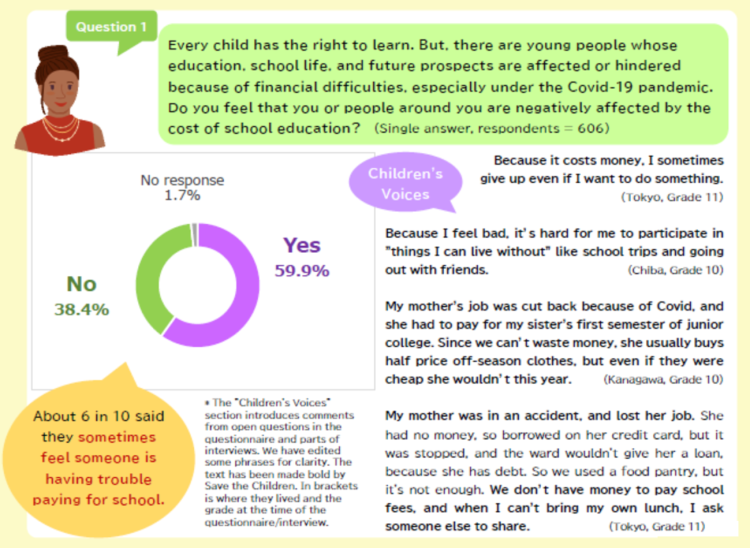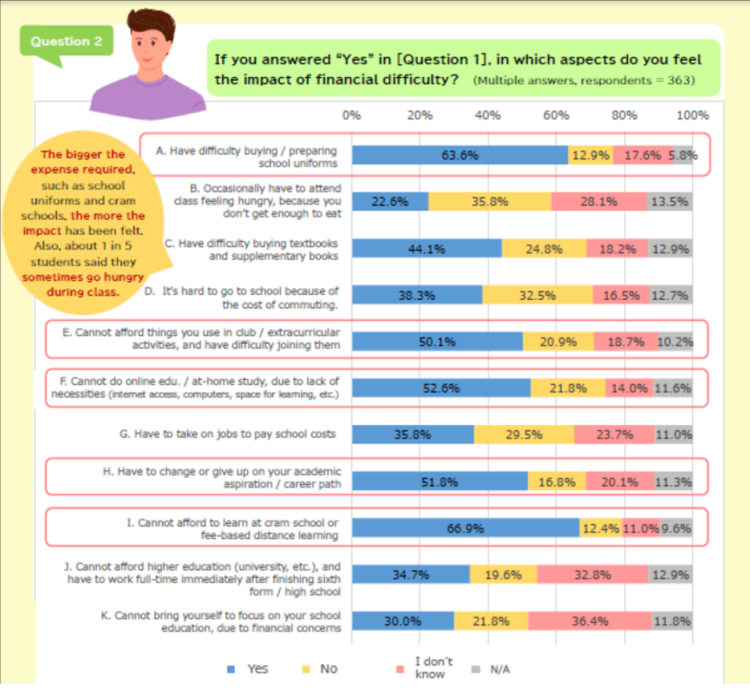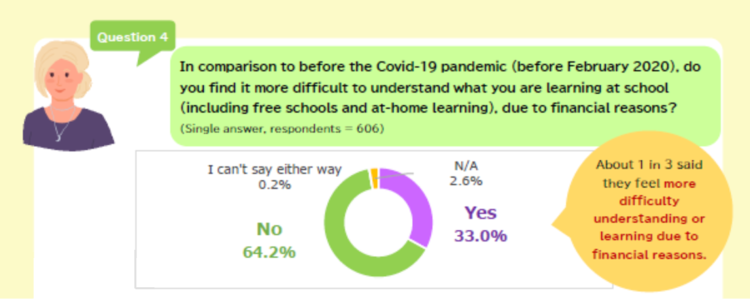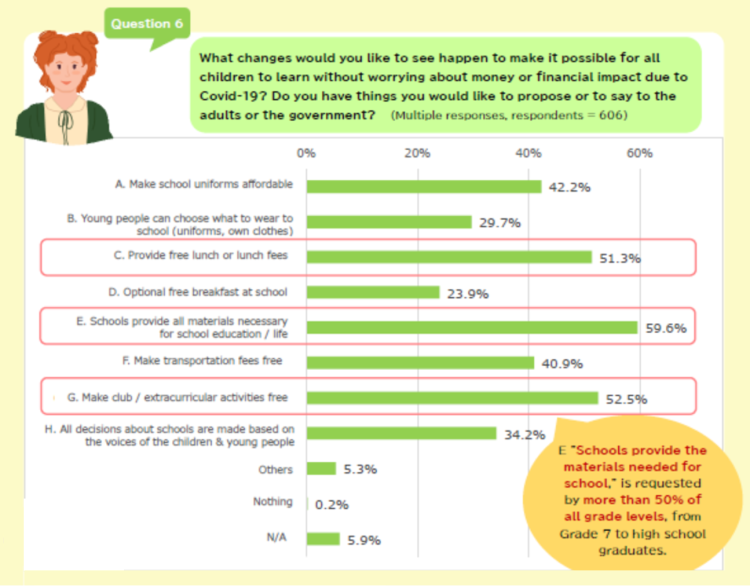Amidst the COVID-19 pandemic, thinking with children about the future of their “right to learn” InsightsEssays: Civil Society in JapanVoices from JNPOCOther Topics
Posted on August 10, 2022
In 2018, Japan NPO Center (JNPOC) started a news & commentary site called NPO CROSS to discuss the role of NPOs/NGOs and civil society as well as social issues in Japan and abroad. We post articles contributed by various stakeholders, including NPOs, foundations, corporations, and volunteer writers.
For this JNPOC’s English site, we select some translated articles from NPO CROSS to introduce to our English-speaking readers.
Amidst the COVID-19 pandemic, thinking with children about the future of their “right to learn”
Since 2020, the COVID-19 pandemic has caused serious damages to those who were already economically disadvantaged. The impact on their livelihood and well-being, especially for those who are working in the service industry in informal employment, has been particularly severe, but most surveys and news reports have basically focused only on adults, and there are surprisingly few chances to learn about the actual conditions of the children.
In October 2021, Save the Children Japan released the “Covid-19 x Child’s Right and Cost to Learn Hearing Report” (English summary version (PDF) posted here). This report is distinct in providing the direct voices and opinions of the children themselves regarding the impact of COVID-19 on their education. We interviewed Mitsue Tashiro and Aki Matsuyama of the Domestic Programs Division who compiled the report.
Concerns for the vicious cycle created by the obstruction of the right to education
The report is based on a survey of 606 children of junior high and high school age in Tokyo and eight other prefectures (Iwate, Miyagi, Nagano, Saitama, Chiba, Kanagawa, Gifu, and Okayama) conducted between April and July 2021, and face-to-face interviews with nine respondents.
In response to the question, “Do you feel that you or people around you are negatively affected by the cost of school education?”, 60% of the children answered “Yes,” and the number was higher in the Tokyo metropolitan area (Tokyo, Saitama, Chiba, and Kanagawa), where 76% or 3 out of 4 children answered “Yes.”
“We knew that there are a certain number of young people in trouble, but the percentage of children who felt this way was higher than we had expected,” said Ms. Tashiro.

Adapted from Save the Children Japan’s Covid-19 x Child’s Right and Cost to Learn Hearing Report (English summary)
When we think of the cost of education, the first thing that comes to mind is school tuition. Some readers may think that the problem is heading towards a solution with the “free tuition policy” for high schools taking effect recently in Japan.
However, according to the Survey of Household Expenditures on Education per Student 2018 (Ministry of Education, Culture, Sports, Science and Technology), the annual cost of education for one child attending a public high school is approximately 460,000 yen, of which school tuition accounts for only about 25,000 yen, or 5.5% of the total. In the case of children attending private high schools, tuition fees account for a much higher percentage, but still only about 23.7% (or about 230,000 yen of around total 1 million yen for annual educational spending). In other words, we cannot appreciate the financial hardship the young people are actually facing, unless we look at the tuition plus the whole range of expenditures necessary for a child’s education.
In this report, many children also reported difficulty in purchasing school uniforms and extracurricular activity supplies, and the financial obstacles to learning through online learning and cram schools. More than 50% of the children who felt the negative impact of the school fees said that they had to give up on or change their future paths.

From Save the Children Japan’s Covid-19 x Child’s Right and Cost to Learn Hearing Report (English summary)
Furthermore, Ms. Matsuyama noted, “It is very troubling that for some of the young people, the financial situations are even influencing their comprehension of what they are studying at school.”
When asked if they find it more difficult to understand what they are learning at school due to financial reasons compared to before the outbreak of COVID-19, one out of three respondents answered “Yes.”

From Save the Children Japan’s Covid-19 x Child’s Right and Cost to Learn Hearing Report (English summary)
Lack of environment necessary for online learning (including access to computers and the Internet, as well as a room environment and a desk suitable for studying) also prevents students from taking online classes and limits their opportunities for independent study using the internet.
Difficulties with comprehension could invoke lack of motivation, and eventually lead to dislike of studying and schools altogether. We must find a way to stop this vicious cycle of the economic disparity among families widening the gap of learning among children from further deteriorating due to the pandemic.
“Schools cost too much”: Young people’s honest views
What can we do to overcome this situation? The report also includes children’s ideas for positive changes.
Ms. Matsuyama said: “Many children find it strange that they have to pay personally for things that are decided and implemented by the school. In the survey, more than 50% of children in all grades responded that they want the ‘schools [to] provide all materials necessary for school education.’”
In the face-to-face interviews, many “common sense” questions were raised by the children, such as whether it really is necessary to specify the types of coats and bags for the students to purchase; why they have to buy things at school while there are less expensive options elsewhere; and why they have to re-purchase equipment for extracurricular activities only at designated stores.
Ms. Tashiro commented, “The children are not asking for everything to be free of charge. They are questioning the fact that excessive money is spent on their own education.”

From Save the Children Japan’s Covid-19 x Child’s Right and Cost to Learn Hearing Report (English summary)
In addition, there were candid questions from the young people about high schools being excluded from compulsory education while it is difficult to find a job in Japan without completing a high school education. Furthermore, some students expressed their concern about tuition waiver and scholarship programs, saying that under the current system, students are required to pay out-of-pocket expenses and get reimbursed a few months later, and that they want people to know how difficult it is to make that first payment.
“In fact, I didn’t expect to hear so many specific stories,” said Ms. Tashiro. “Children are more flexible and have more opinions about money issues than the adults might imagine. But the reality is that there are very few places and opportunities for them to express their opinions safely.”
Envisioning comprehensive free education, together with children
Concurrently with this report, Save the Children Japan has released the Proposal on Comprehensive Free Education for All Children (available in Japanese)”.

Left: Ms. Mitsue Tashiro; Right: Ms. Aki Matsuyama
Ms. Tashiro says: “Article 28 of the UN Convention on the Rights of the Child guarantees the right of the child to education, and calls on States Parties to the Convention to make efforts to ensure this right based on equal opportunity. In Japan, financial support for school education is still predominantly considered equivalent to exemptions or subsidies for tuition. The survey and interviews with children brought to light the need for free education to also include expenses other than tuition, such as the cost of educational materials, uniforms, and extracurricular activities. We will now be seeking policymakers to discuss and develop a roadmap for free education in this broader sense.”
Ms. Matsuyama continues: “We are also asking that the young people have their opinions heard and be included in the development of the roadmap. While adults have the electoral system and numerous means to express their will, children do not have that option. Young people are rarely asked for their thoughts on national and local policies, or even in school matters, and there are virtually no accountability to young people on decisions made. Article 12 of the UN Convention on the Rights of the Child guarantees children the right to be heard, to express their views freely in all matters that concern them.”
Save the Children Japan will continue to engage the Ministry of Education and other relevant ministries, as well as lawmakers and local governments.
Protecting children’s right to learn is not only a matter for children, but also concerns the future of the nation, especially amid growing concerns over the division in society and widening disparities.
Through this report, we hope that more people will become aware of the financial burden of education and the realities children face, and understand the need to have the children’s thoughts be heard.
Some of the issues that need to be addressed, such as uniforms, educational materials, and extracurricular activity fees, may be reviewed on a school-by-school basis with the efforts of parents, teachers and local partners. If you have a chance to get engaged and make a difference, we hope that you will listen to the voices of the children as well.
Original text by Yukiko Okuyama (JNPOC’s volunteer writer) & originally posted on December 3, 2021; text translated by JNPOC
Recent Articles
- How Do Japanese Non-profit Organizations (NPOs) Feel About the SDGs?
- A Place where People with Difficulties in Life Can Support Each Other: Valuing Loose Connections
- How They Give is Changing and the Implications for Japan’s Nonprofit Sector
- What Local NPOs Can Do to Prepare for the Next Disaster – Proposals from the 311 Change Association
- Should Only Education in School Count? ~ How Can We Protect the Dignity of Citizens? The Value of Civic Engagement is Questioned.
- The appointment of the new chairperson of the board took place